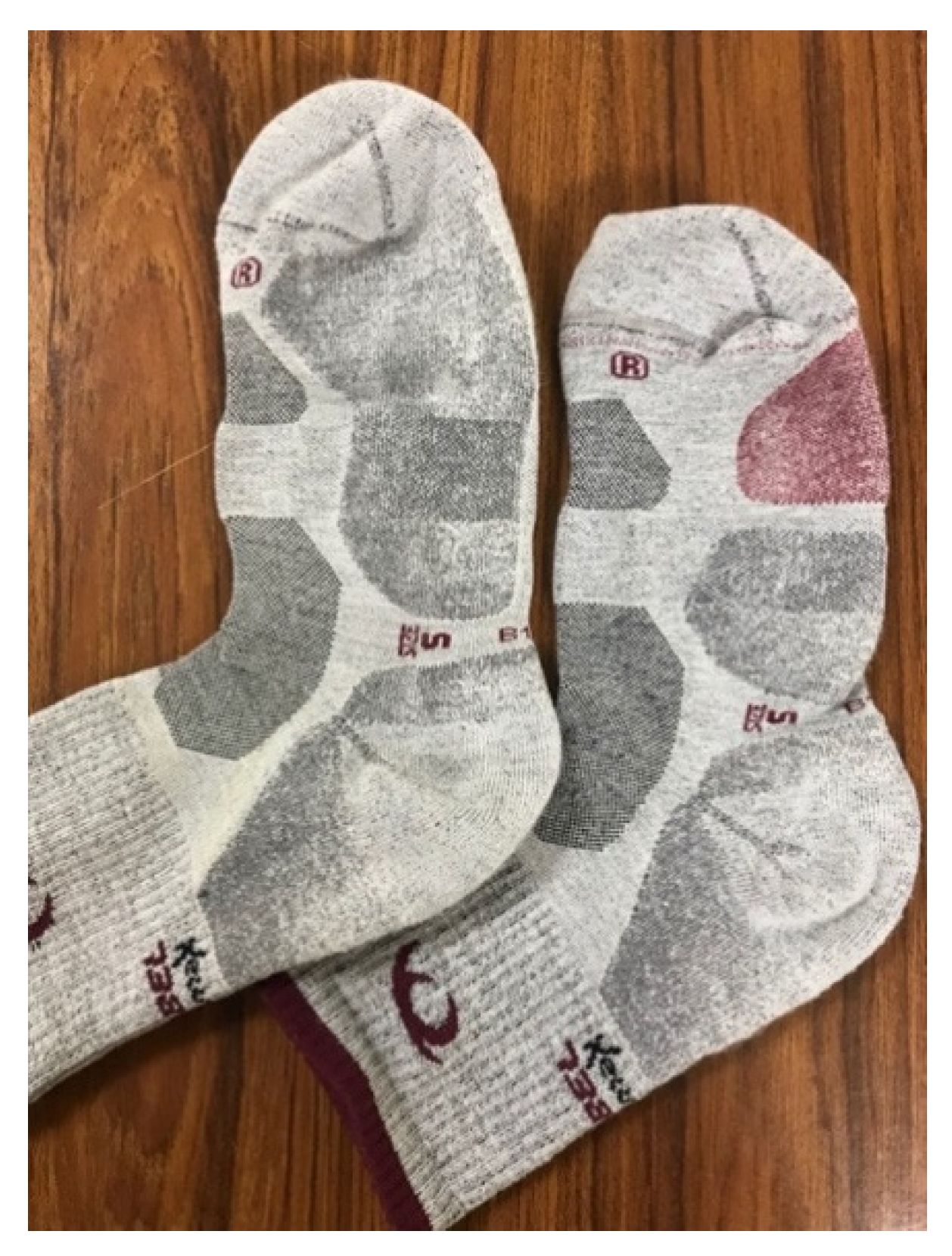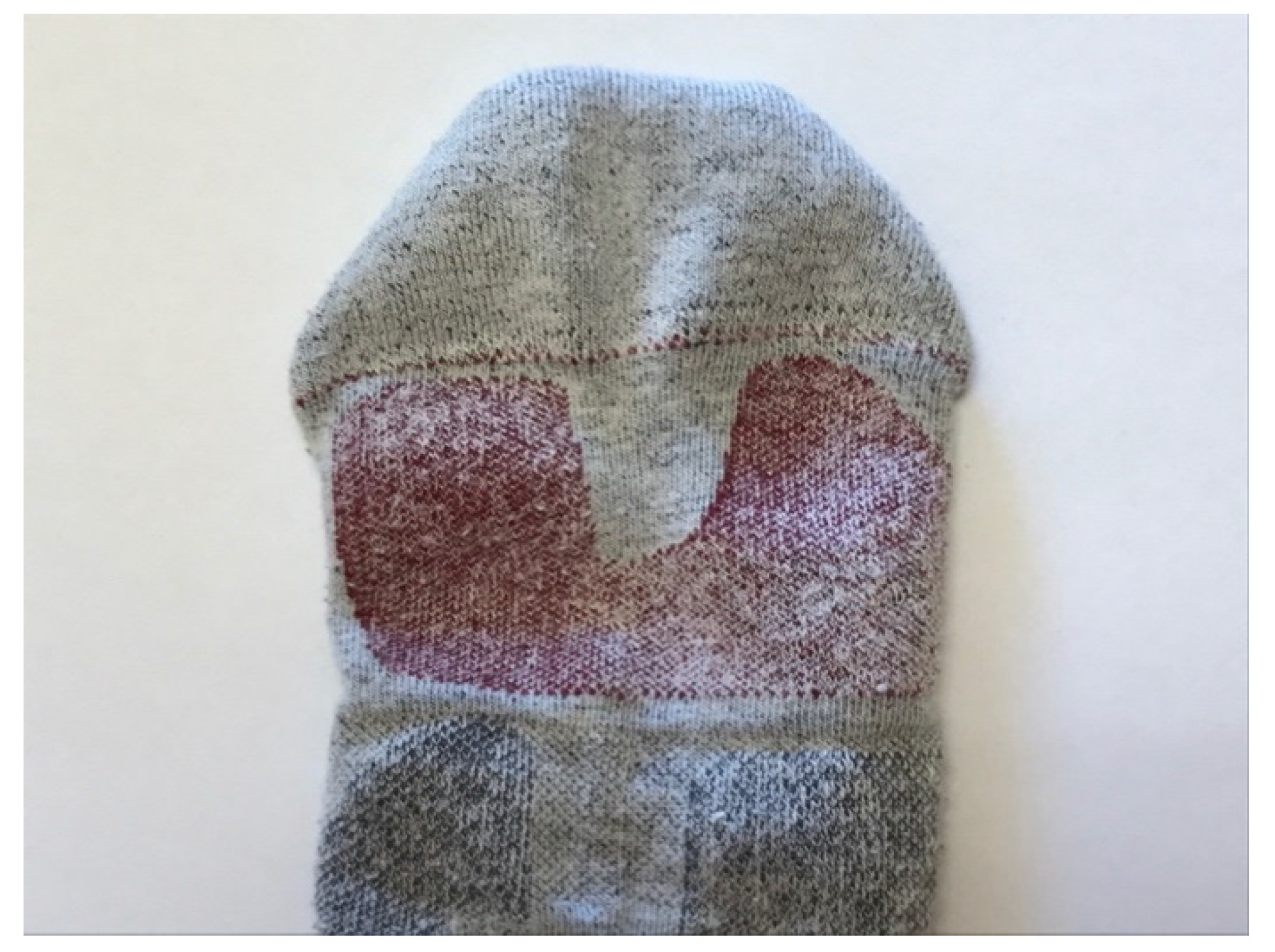Effectiveness of a Central Discharge Element Sock for Plantar Temperature Reduction and Improving Comfort
Abstract
:1. Introduction
2. Materials and Methods
2.1. Participants
2.2. Instruments and Procedure
2.2.1. Thermographic Analysis
2.2.2. Socks
2.2.3. Walking Protocol
2.2.4. Comfort Questionnaire
2.3. Analysis of Thermographic Variables
2.4. Statistical Analysis
3. Results
4. Discussion
5. Limitations of the Study
6. Conclusions
Author Contributions
Funding
Institutional Review Board Statement
Informed Consent Statement
Conflicts of Interest
References
- Niedermeier, M.; Einwanger, J.; Hartl, A.; Kopp, M. Affective responses in mountain hiking—A randomized crossover trial focusing on differences between indoor and outdoor activity. PLoS ONE 2017, 12, e177719. [Google Scholar] [CrossRef] [PubMed]
- Chicharro-Luna, E.; Martínez-Nova, A.; Ortega-Ávila, A.B.; Requena-Martínez, A.; Gijón-Noguerón, G. Prevalence and risk factors associated with the formation of dermal lesions on the foot during hiking. J. Tissue Viabil. 2020, 29, 218–223. [Google Scholar] [CrossRef]
- Maceira, E.; Monteagudo, M. Mechanical Basis of Metatarsalgia. Foot Ankle Clin. 2019, 24, 571–584. [Google Scholar] [CrossRef] [PubMed]
- Besse, J.L. Metatarsalgia. In Orthopaedics and Traumatology: Surgery and Research; Elsevier Masson SAS: Barcelona, Spain, 2017; Volume 103, pp. S29–S39. [Google Scholar]
- Putti, A.B.; Arnold, G.P.; Cochrane, L.A.; Abboud, R.J. Normal pressure values and repeatability of the Emed® ST4 system. Gait Posture 2008, 27, 501–505. [Google Scholar] [CrossRef]
- Espinosa, N.; Brodsky, J.W.; Maceira, E. Metatarsalgia. J. Am. Acad. Orthop. Surg. 2010, 18, 474–485. [Google Scholar] [CrossRef] [PubMed]
- Chang, B.C.; Liu, D.H.; Chang, J.L.; Lee, S.H.; Wang, J.Y. Plantar pressure analysis of accommodative insole in older people with metatarsalgia. Gait Posture 2014, 39, 449–454. [Google Scholar] [CrossRef] [PubMed]
- Nordsiden, L.; Van Lunen, B.L.; Walker, M.L.; Cortes, N.; Pasquale, M.; Onate, J.A. The effect of 3 foot pads on plantar pressure of pes planus foot type. J. Sport Rehabil. 2010, 19, 71–85. [Google Scholar] [CrossRef] [PubMed]
- Männikkö, K.; Sahlman, J. The Effect of Metatarsal Padding on Pain and Functional Ability in Metatarsalgia. Scand. J. Surg. 2017, 106, 332–337. [Google Scholar] [CrossRef] [PubMed] [Green Version]
- Nieto-García, E.; Ferrer-Torregrosa, J.; Ramírez-Andrés, L.; Nieto-González, E.; Martinez-Nova, A.; Barrios, C. The impact of associated tenotomies on the outcome of incomplete phalangeal osteotomies for lesser toe deformities. J. Orthop. Surg. Res. 2019, 14, 308. [Google Scholar] [CrossRef] [PubMed]
- Zimny, S.; Schatz, H.; Pfohl, U. The effects of applied felted foam on wound healing and healing times in the therapy of neuropathic diabetic foot ulcers. Diabet. Med. 2003, 20, 622–625. [Google Scholar] [CrossRef]
- Gatt, A.; Briffa, A.; Chockalingam, N.; Formosa, C. The applicability of plantar padding in reducing peak plantar pressure in the forefeet of healthy adults: Implications for the foot at risk. J. Am. Podiatr. Med. Assoc. 2016, 106, 246–251. [Google Scholar] [CrossRef]
- Hähni, M.; Hirschmüller, A.; Baur, H. The effect of foot orthoses with forefoot cushioning or metatarsal pad on forefoot peak plantar pressure in running. J. Foot Ankle Res. 2016, 9, 44. [Google Scholar] [CrossRef] [PubMed] [Green Version]
- Baussan, E.; Bueno, M.; Rossi, R.; Derler, S. Analysis of current running sock structures with regard to blister prevention. Textile Res. J. 2013, 83, 836–848. [Google Scholar] [CrossRef]
- Soltanzadeh, Z.; Shaikhzadeh Najar, S.; Haghpanahi, M.; Mohajeri-Tehrani, M.R. Effect of socks structures on plantar dynamic pressure distribution. Proc. Inst. Mech. Eng. H 2016, 230, 1043–1050. [Google Scholar] [CrossRef] [PubMed]
- Soltanzadeh, Z.; Shaikhzadehnajar, S.; Haghpanahi, M.; Mohajeri-Tehrani, M.R. Plantar static pressure distribution in normal feet using cotton socks with different structures. J. Am. Podiatr. Med. Assoc. 2017, 107, 30–38. [Google Scholar] [CrossRef] [PubMed]
- Martínez-Nova, A.; Sánchez-Rodríguez, R.; Gómez-Martín, B.; Escamilla Martínez, E. Calcetín de Alivio Metatarsal. Patent ES 1247681 U, 23 April 2020. [Google Scholar]
- Cholewka, A.; Drzazga, Z.; Sieron, A.; Stanek, A.; Knefel, G.; Kawecki, M.; Nowak, M. Some applications of thermal imaging in medicine in some aspects of medical physics—in vivo and in vitro studies. Pol. J. Environ. Stud. 2010, 1, 51–58. [Google Scholar]
- El-Nahas, M.; El-Shazly, S.; El-Gamel, F.; Motawea, M.; Kyrillos, F.; Idrees, H. Relationship between skin temperature monitoring with Smart Socks and plantar pressure distribution: A pilot study. J. Wound Care 2018, 27, 536–541. [Google Scholar] [CrossRef]
- Yavuz, M.; Brem, R.W.; Davis, B.L.; Patel, J.; Osbourne, A.; Matassini, M.R.; Wood, D.A.; Nwokolo, I.O. Temperature as a predictive tool for plantar triaxial loading. J. Biomech. 2014, 47, 3767–3770. [Google Scholar] [CrossRef] [PubMed]
- Escamilla-Martínez, E.; Gómez-Martín, B.; Sánchez-Rodríguez, R.; Fernández-Seguín, L.M.; Pérez-Soriano, P.; Martínez-Nova, A. Running thermoregulation effects using bioceramics versus polyester fibres socks. J. Ind. Text. 2020, 152808371989885. [Google Scholar] [CrossRef]
- Baic, A.; Kasprzyk, T.; Rżany, M.; Stanek, A.; Sieroń, K.; Suszyński, K.; Marcol, W.; Cholewka, A. Can we use thermal imaging to evaluate the effects of carpal tunnel syndrome surgical decompression? Medicine 2017, 1, 96. [Google Scholar] [CrossRef] [PubMed]
- Gatt, A.; Formosa, C.; Cassar, K.; Camilleri, K.P.; De Raffaele, C.; Mizzi, A.; Azzopardi, C.; Mizzi, S.; Falzon, O.; Cristina, S.; et al. Thermographic Patterns of the Upper and Lower Limbs: Baseline Data. Int. J. Vasc. Med. 2015, 2015, 831369. [Google Scholar] [CrossRef]
- Kasprzyk-Kucewicz, T.; Cholewka, A.; Bałamut, K.; Kownacki, P.; Kaszuba, N.; Kaszuba, M.; Stanek, A.; Sieroń, K.; Stransky, J.; Pasz, A.; et al. The applications of infrared thermography in surgical removal of retained teeth effects assessment. J. Therm. Anal. Calorim. 2021, 144, 139–144. [Google Scholar] [CrossRef] [Green Version]
- Menz, H.B. Two feet, or one person? Problems associated with statistical analysis of paired data in foot and ankle medicine. Foot 2004, 14, 2–5. [Google Scholar] [CrossRef]
- Watanabe, R.; Kajimoto, H. Effect of Dynamic Temperature Stimulus to Plantar Surface of the Foot in the Standing Position. Front. Bioeng. Biotechnol. 2016, 21, 4–88. [Google Scholar] [CrossRef] [PubMed] [Green Version]
- Buldt, A.K.; Forghany, S.; Landorf, K.B.; Levinger, P.; Murley, G.S.; Menz, H.B. Foot posture is associated with plantar pressure during gait: A comparison of normal, planus and cavus feet. Gait Posture 2018, 62, 235–240. [Google Scholar] [CrossRef] [PubMed]
- Mori, T.; Nagase, T.; Takehara, K.; Oe, M.; Ohashi, Y.; Amemiya, A.; Noguchi, H.; Ueki, K.; Kadowaki, T.; Sanada, H. Morphological pattern classification system for plantar thermography of patients with diabetes. J. Diabetes Sci. Technol. 2013, 7, 1102–1112. [Google Scholar] [CrossRef] [Green Version]
- Reddy, P.N.; Cooper, G.; Weightman, A.; Hodson-Tole, E.; Reeves, N.D. Walking cadence affects rate of plantar foot temperature change but not final temperature in younger and older adults. Gait Posture 2016, 52, 272–279. [Google Scholar] [CrossRef] [PubMed]
- Cazzaniga, S.; Scocco, G.L.; Schincaglia, E.; Mercuri, S.R.; Chimenti, S.; Saraceno, R.; Naldi, L. Clinical Trial Comparing Fluorine-Synthetic Fiber Socks with Standard Cotton Socks in Improving Plantar Pustulosis. Dermatology 2014, 228, 166–171. [Google Scholar] [CrossRef] [PubMed]
- Aparicio, I.; Giménez, J.V.; Pérez-Soriano, P.; Martínez-Nova, A.; Macián, C.; Llana, S. Evaluación de tecnología regenactiv en calcetines durante la marcha nórdica. Eur. J. Hum. Movem. 2012, 28, 101–110. [Google Scholar]
- Zatcoff, R.C.; Smith, M.S.; Borkow, G. Treatment of tinea pedis with socks containing copper-oxide impregnated fibers. Foot 2008, 18, 136–141. [Google Scholar] [CrossRef]
- Liu, H.; Lee, Y.-Y.; Norsten, T.B.; Chong, K. In situ formation of anti-bacterial silver nanoparticles on cotton textiles. J. Ind. Text. 2013, 44, 198–210. [Google Scholar] [CrossRef]
- Martínez Nova, A.; Marcos-Tejedor, F.; Gómez Martín, B.; Sánchez-Rodríguez, R.; Escamilla-Martínez, E. Bioceramic-fiber socks have more benefits than cotton-made socks in controlling bacterial load and the increase of sweat in runners. Text. Res. J. 2018, 88, 696–703. [Google Scholar] [CrossRef]
- Borkow, G.; Zatcoff, R.C.; Gabbay, J. Reducing the risk of skin pathologies in diabetics by using copper impregnated socks. Med. Hypotheses 2009, 73, 883–886. [Google Scholar] [CrossRef]
- Pico, A.M.P.; Álvarez, E.M.; Quintana, R.M.; Acevedo, R.M. Importance of sock type in the development of foot lesions on low-difficulty, short hikes. Int. J. Environ. Res. Public Health 2019, 16, 1871. [Google Scholar] [CrossRef] [PubMed] [Green Version]
- Pérez Pico, A.M.; Mingorance Álvarez, E.; Caballé Cervigón, N.; Mayordomo Acevedo, R. Importance of Preexisting Physical Factors in the Development of Dermatological and Muscular Lesions During Hiking. Int. J. Low Extrem. Wounds 2019, 18, 161–170. [Google Scholar] [CrossRef] [PubMed]
- Nieto-Gil, M.P.; Ortega-Avila, A.B.; Pardo-Rios, M.; Gijon-Nogueron, G. Effectiveness and duration of plantar pressure off-loading by two designs of felt padding: A preliminary study. J. Am. Podiatr. Med. Assoc. 2019, 109, 431–436. [Google Scholar] [CrossRef] [PubMed]
- Pascual-huerta, J. S-Plasty for excision of a circular lession of the hallux: A case report. Rev. Esp. Podol. 2018, 29, 94–100. [Google Scholar] [CrossRef]
- Llopart Lobato, L.; Ruiz Arredondo, D. Descargas Provisionales. Rev. Esp. Podol. 1998, 9, 127–157. [Google Scholar]



| Mean ± SD (°C) | Gender | Mean ± SD (°C) | p Value | |
|---|---|---|---|---|
| First MTH | 28.0 ± 2.8 | Men Women | 27.0 ± 3.2 | 0.115 |
| 28.5 ± 2.5 | ||||
| Second/third MTH | 28.3 ± 2.7 | Men Women | 27.3 ± 3.0 | 0.141 |
| 28.7 ± 2.5 | ||||
| Fourth/fifth MTH | 27.6 ± 2.7 | Men Women | 26.9 ± 2.9 | 0.250 |
| 28.0 ± 2.6 | ||||
| Hallux | 26.1 ± 3.7 | Men Women | 25.3 ± 4.1 | 0.319 |
| 26.6 ± 3.4 | ||||
| Lesser toes | 25.9 ± 3.4 | Men Women | 25.5 ± 3.8 | 0.555 |
| 26.2 ± 3.2 |
| Base | Control | Experimental | W Mauchly (Sig) | Pillai’s Trace | p Value | |
|---|---|---|---|---|---|---|
| Mean (°C) | ||||||
| First MTH | 28.1 | 31.1 | 31.2 | 0.986 (p = 0.788) | 0.701 | <0.001 * |
| Second/third MTH | 28.3 | 31.6 | 30.6 | 0.977 (p = 0.622) | 0.656 | <0.001 *† |
| Fourth/fifth MTH | 27.6 | 30.5 | 30.6 | 0.974 (p = 0.623) | 0.600 | <0.001 * |
| Hallux | 26.2 | 29.5 | 29.7 | 0.971 (p = 0.588) | 0.579 | <0.001 * |
| Lesser toes | 25.9 | 29.2 | 29.3 | 0.999 (p = 0.977) | 0.566 | <0.001 * |
Publisher’s Note: MDPI stays neutral with regard to jurisdictional claims in published maps and institutional affiliations. |
© 2021 by the authors. Licensee MDPI, Basel, Switzerland. This article is an open access article distributed under the terms and conditions of the Creative Commons Attribution (CC BY) license (https://creativecommons.org/licenses/by/4.0/).
Share and Cite
Martínez-Nova, A.; Jiménez-Cano, V.M.; Caracuel-López, J.M.; Gómez-Martín, B.; Escamilla-Martínez, E.; Sánchez-Rodríguez, R. Effectiveness of a Central Discharge Element Sock for Plantar Temperature Reduction and Improving Comfort. Int. J. Environ. Res. Public Health 2021, 18, 6011. https://doi.org/10.3390/ijerph18116011
Martínez-Nova A, Jiménez-Cano VM, Caracuel-López JM, Gómez-Martín B, Escamilla-Martínez E, Sánchez-Rodríguez R. Effectiveness of a Central Discharge Element Sock for Plantar Temperature Reduction and Improving Comfort. International Journal of Environmental Research and Public Health. 2021; 18(11):6011. https://doi.org/10.3390/ijerph18116011
Chicago/Turabian StyleMartínez-Nova, Alfonso, Víctor Manuel Jiménez-Cano, Juan Miguel Caracuel-López, Beatriz Gómez-Martín, Elena Escamilla-Martínez, and Raquel Sánchez-Rodríguez. 2021. "Effectiveness of a Central Discharge Element Sock for Plantar Temperature Reduction and Improving Comfort" International Journal of Environmental Research and Public Health 18, no. 11: 6011. https://doi.org/10.3390/ijerph18116011
APA StyleMartínez-Nova, A., Jiménez-Cano, V. M., Caracuel-López, J. M., Gómez-Martín, B., Escamilla-Martínez, E., & Sánchez-Rodríguez, R. (2021). Effectiveness of a Central Discharge Element Sock for Plantar Temperature Reduction and Improving Comfort. International Journal of Environmental Research and Public Health, 18(11), 6011. https://doi.org/10.3390/ijerph18116011







